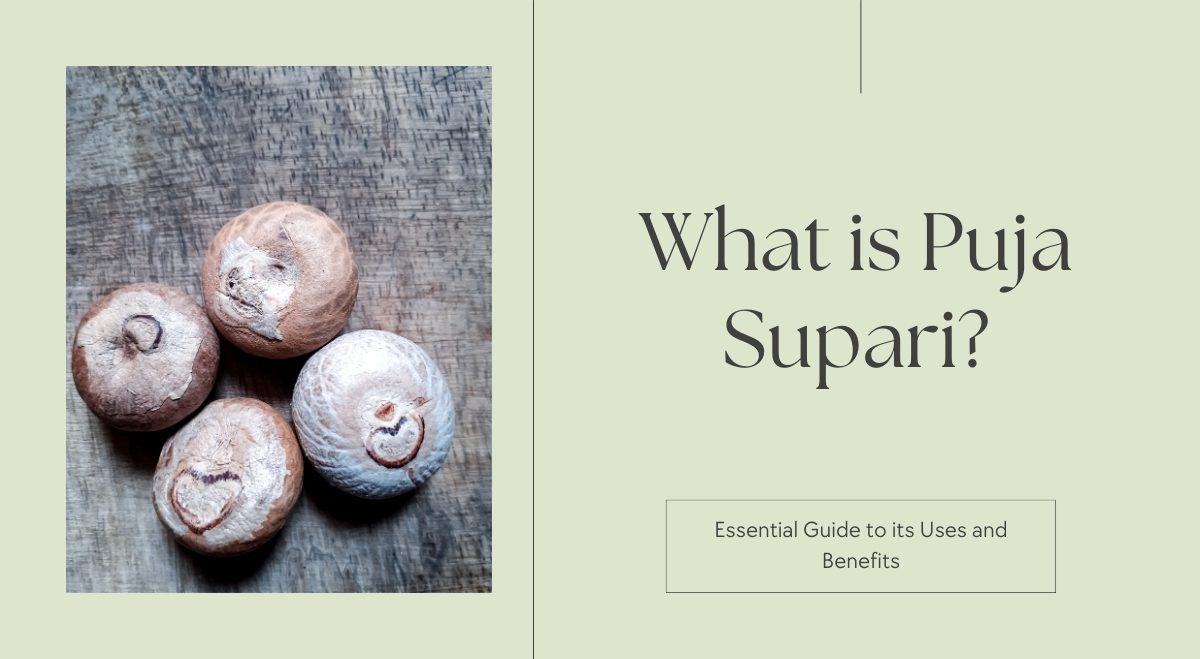Did you know that a small nut, no bigger than a marble, has played a crucial role in Hindu rituals for thousands of years? This humble yet powerful object, known as Puja Supari, has been revered in Indian culture since ancient times. In this comprehensive guide, we’ll explore the fascinating world of Puja Supari, its rich history, and its enduring significance in Hindu traditions.
What is Puja Supari?
Puja Supari, also known as betel nut or areca nut, is the fruit of the areca palm tree (Areca catechu). This small, oval-shaped nut has a hard exterior and a slightly astringent taste. In Sanskrit, it’s called “Pugiphala,” in Hindi, it’s commonly referred to as “Supari.”
Physical Characteristics
- Shape: Usually conical or rounded
- Color: Pale brown
- Texture: Woody and hard
The Significance of Puja Supari in Hinduism
Puja Supari holds a special place in Hindu rituals due to its symbolic representation and perceived divine qualities.
Divine Representation
In Hindu belief, Puja Supari is considered a symbol of the divine. It’s often used to represent various deities during rituals when idols are not available. For example:
- Lord Ganesha: The conical shape of the supari is said to resemble Ganesha’s head
- Goddess Lakshmi: The nut’s association with prosperity makes it a suitable representation
- Lord Vishnu: In some traditions, the supari symbolizes the cosmic egg from which Vishnu emerged
Symbolic Meaning
The hardness of the supari is seen as a representation of the human ego. When offered during puja, it symbolizes the surrender of one’s ego to the divine, leaving only pure qualities behind.
Uses of Puja Supari in Rituals
Puja Supari plays a versatile role in Hindu ceremonies and rituals.
In Daily Puja
Many Hindu households include Puja Supari in their daily worship. It’s often placed near the deity or on the altar as an offering.
During Special Ceremonies
- Weddings: Supari is tied to the wedding pandal and the bridegroom’s clothes, believed to bring prosperity.
- Navgraha Puja: In this ritual dedicated to the nine planets, supari is used to represent each celestial body.
- Representing Absent Family Members: In some regions, a supari wrapped in a cloth can symbolize an absent family member during important rituals.
Benefits of Using Puja Supari
The use of Puja Supari is believed to bring both spiritual and physical benefits.
Spiritual Benefits
- Divine Presence: It’s believed to invite the presence of deities like Brahma, Yama, Varuna, and Indra during rituals.
- Removal of Obstacles: Offering supari is thought to help overcome life’s difficulties and challenges.
- Prosperity: In many traditions, supari is associated with increased wealth and abundance.
Traditional Beliefs About Physical Benefits
While primarily used for spiritual purposes, supari has some traditional medicinal uses. It’s important to note that these are based on cultural beliefs and lack scientific validation:
- Digestion Aid: Some believe chewing a small piece of supari aids digestion and reduces excess saliva.
- Cholesterol Management: Some traditional medicine practitioners claim it helps reduce cholesterol levels, though this is not scientifically proven.
How to Use Puja Supari
The use of Puja Supari can vary widely depending on specific rituals, traditions, or family customs. Here are some common practices, but remember that these may differ based on your particular tradition:
- Selection: Choose small, conical-shaped supari for rituals, as these are often considered more auspicious in many traditions.
- Placement: In some households, supari is placed in the northeast corner of the home, preferably in a silver vessel. However, the exact location may vary based on regional customs.
- Daily Worship: Some devotees offer daily prayers to the supari, treating it as a representation of Lord Ganesha or other deities.
- Prosperity Rituals: In certain practices, supari wrapped in red cloth is kept in the center of a Sri Yantra for financial blessings.
- Offering: During puja, supari may be offered along with other items like flowers, fruits, and sweets.
Remember, these are general guidelines. It’s always best to consult with a knowledgeable elder, priest, or spiritual guide familiar with your specific tradition for the most appropriate way to incorporate Puja Supari into your rituals.
Cultural Variations in Puja Supari Use
The use of Puja Supari varies across different regions of India:
- Maharashtra: A supari wrapped in cloth can represent an absent wife during rituals.
- Bengal: Supari is believed to have magical properties and is sometimes placed under pillows to induce prophetic dreams.
- North-West India: A special ritual called Deonar puja is performed when planting areca nut trees.
Precautions and Considerations
While Puja Supari is sacred in rituals, it’s important to note:
- The supari used in puja is different from the one used for consumption. Ritual supari is usually smaller and more conical.
- Puja Supari should not be consumed after the ritual. It’s typically donated to a Brahmin or immersed in flowing water.
- While supari has traditional uses, its consumption is not recommended due to potential health risks.
Conclusion
Puja Supari, with its rich symbolism and cultural significance, continues to play a vital role in Hindu rituals. From representing deities to symbolizing the surrender of ego, this small nut carries profound meaning. Whether you’re a practitioner of Hinduism or simply interested in cultural traditions, understanding the importance of Puja Supari offers valuable insight into the depth and complexity of Hindu rituals.
As you explore the world of Hindu practices, remember that each element, no matter how small, carries its own unique significance. The humble Puja Supari is a perfect example of how even the simplest objects can hold deep spiritual meaning.
Have you ever used Puja Supari in your rituals or witnessed its use in a ceremony? We’d love to hear about your experiences and the significance it held for you. Share your stories in the comments below and join the conversation about this fascinating aspect of Hindu culture.

